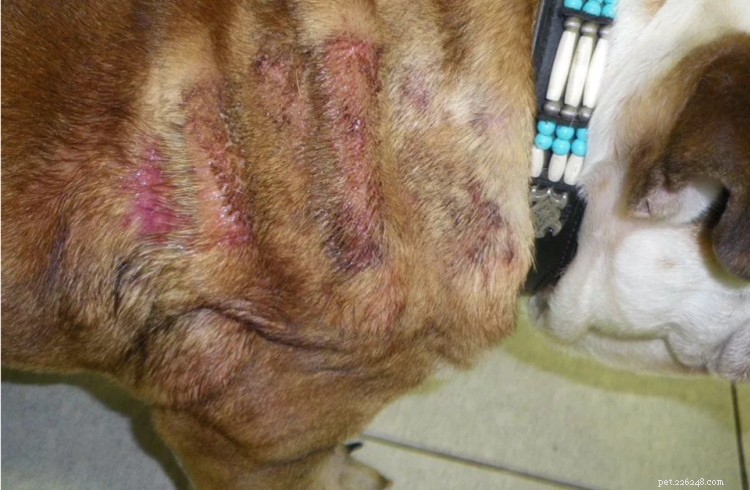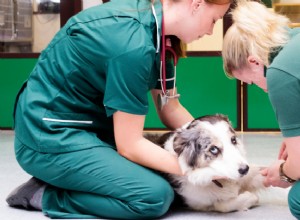あなたの毛皮のような友人が不快に見えたり、体をかゆくしたり引っ掻いたりするのに多くの時間を費やしている場合は、イースト菌感染症にかかっている可能性があります.犬のイースト菌感染症は、皮膚のどこにでも発生する可能性があり、治療が難しいことが判明している一般的な状態です.
この投稿では、犬のイースト菌感染症の症状を認識する方法、状態を治療する方法、および細菌感染症やアレルギー反応と区別する方法を学びます.
プロのヒント: 皮膚の状態に対するペット保険の請求は、治療が侵襲性が低いため、他の病気よりも費用がかからない傾向があります。ただし、子犬は、真菌感染を制御し、かゆみを軽減するために継続的な投薬が必要になる場合があります。これは、処方薬を補償するペット保険に加入していないと、かなり高額になる可能性があります。
 (画像提供元:Paw Culture)
(画像提供元:Paw Culture)
イースト菌感染症 (またはイースト菌皮膚炎) は、犬によく見られる炎症性皮膚疾患です .酵母生物は、体の正常なフローラの一部として犬に常に存在しますが、特定の領域 (通常は耳、皮膚のひだ、または足の裏の間) に過剰な量の酵母が存在すると、真菌感染が発生します。
通常、犬のイースト菌感染症は、別の根本的な問題が原因で発生します。たとえば、免疫システムが損なわれている、環境アレルギー、または食物アレルギーのある子犬に発生する可能性が高くなります。特に、抗生物質やステロイドを服用している場合.
抗生物質はイースト菌の原因にはなりませんが、抗生物質を長期間使用すると、そのレベルを制御するのに役立つ健康なフローラの存在が減少し、イースト菌の異常増殖につながる可能性があります.ステロイドはまた、ペットの免疫システムに悪影響を与える可能性があり、酵母が過剰に増殖する可能性があります.
高温多湿の天候、細菌感染、アトピー性皮膚炎などの基礎疾患も、犬のイースト菌感染症につながるリスク要因です。
毛むくじゃらの友達がいつもより多く引っ掻く原因となるのは、イースト菌感染だけではありません。かゆみの症状は、次のようなまったく別の何かを示している可能性があります:
細菌性皮膚感染症は炎症を引き起こし、細菌によって生成される毒素が原因で、犬の皮膚に赤み、発疹、痂皮、膿疱が発生する可能性があります。これは次の場合に発生する可能性があります:
ダニ、ノミ、ホルモンの不均衡、遺伝、および特定の薬も、ペットが膿皮症などの細菌性皮膚感染症を発症するリスクを高める可能性があります.
犬の皮膚のかゆみのもう1つの一般的な原因はアレルギーです。人間は軽度のアレルギー反応でくしゃみをすることがありますが、犬は皮膚のかゆみを経験する傾向があります。食物アレルギーは生涯いつでも発症する可能性があります。
カビ、イエダニ、花粉などの環境要因も、犬の持続的なかゆみの原因となる可能性があり、多くの場合、1 年の特定の時期に激しい引っかき傷を伴います。
ペットの飼い主は、自宅でイースト菌感染症、細菌感染症、アレルギー反応の違いを見分けることができないため、子犬を獣医に連れて行くのが最善の策です.
Only a vet can truly determine the cause behind the constant scratching, but there are a few symptoms that may provide an indication. Unlike allergic reactions and bacterial infections, yeast infection symptoms most commonly affect specific parts of the body.
Yeast infection in the ear canal is very common in canines. In most cases, there is redness, swelling, and brown discharge, accompanied by a musty or sweet smell. Ear infections are usually very itchy, causing your pooch to rub their head or scratch their ears excessively.
You may also notice other symptoms like crusted skin on the ear flap, loss of hair around the ear, head tilting or shaking, walking in circles, loss of hearing, loss of balance, and unusual eye movement.
Yeast dermatitis can occur anywhere on a dog’s skin, especially in moist skin folds, around the face and neck, where the legs meet the body, as well as on the anus and vulva.
The infected skin might be itchy, irritated, red, flaky, or greasy, and accompanied by hair loss. If the yeast infection is chronic, the dog’s skin might become thicker and darker. Yeast infections can also affect your pup’s face or mouth, in which case there will be lots of face rubbing and itching.
You might also notice hair loss on the upper back and tail, speckles on the underbelly, rust or grayish color around the genitals, and diarrhea.
Yeast infections can also affect your pet’s paws making them itchy, red, and irritated. In some cases, this is accompanied by a brown discharge in the nail beds and hair loss. The most affected part of the paws is the underside between the pads. Pups with yeast on their paws tend to lick their paws more than usual.
Some dog breeds are more prone to yeast infections than others, based on their body features like many skin folds or genetics.これらには以下が含まれます:
Ear yeast infections are more common in dogs with floppy ears, such as poodles, basset hounds, Labrador retrievers, and golden retrievers. Some breeds that have hair growing in the inner ear canal, such as Schnauzers, are also more prone to ear yeast infection.
 (Image source:The Spruce Pets)
(Image source:The Spruce Pets)
If you notice any of these symptoms, be sure to take your pet to the vet. He or she will perform cytology, i.e. take a sample from the pup’s infected skin or ear and review it under a microscope to confirm if there’s a yeast infection.
Your vet will also analyze the sample for other immune system issues because canines with yeast infections usually also have skin mites or bacterial infections.
The best treatment depends on the location of the infection.
Yeast infection of the outer ear canal is usually treated with antifungal drops or ointment. An infection of the middle ear will be treated with medications (injections and tablets), although additional tests and even surgery might be necessary. Your vet might also recommend a full cleaning of the pup’s ear canal. If the infection is chronic, ask about special ear cleansers you can use at home.
Ear infections can be covered by pet insurance, but it will depend on the type of pet insurance plan you have, as well as other factors like your pup's history. If you are looking for a new insurance policy but your dog has suffered from an ear infection in the past, consider a plan that covers pre-existing conditions.
Treatments for yeast infections on the skin may include medicated shampoo, topical creams, and antifungal sprays or wipes. All these products contain ingredients effective in treating yeast infections such as ketoconazole, miconazole, and chlorhexidine.
In more severe cases, if the problem persists or appears to worsen, oral antifungal medications are also prescribed. These medications should only be used under a vet’s direction.
Yeast infections can be prevented. Besides making changes and additions to your pup’s diet, you should also consider using an antifungal shampoo. Bear in mind though that for shampoo treatment to be effective, it must sit on your pet’s skin for at least 10 minutes before rinsing.
Dogs with many skin folds might need maintenance treatment to keep these areas from becoming too moist, whereas those allergic to yeast can get an allergy vaccine.
If you suspect your four-legged pal has a yeast infection, talk to your vet for a diagnosis and treatment plan that’s appropriate for your pooch.

あなたの犬はいつもよりも頻繁につまずいたり、よろめいたり、転んだりしていますか?もしそうなら、バランスの喪失は、運動失調として知られる病状が原因である可能性があります.運動失調は、協調運動の喪失をもたらす感覚機能障害に関連する状態です。これは深刻な健康問題であり、直ちに獣医の診察が必要です。 犬の運動失調症の症状が発生した場合に、その症状をよりよく認識できるように、この状態についてさらに学習するために読み続けてください. 目次: 運動失調とは? 犬の運動失調の原因 犬の運動失調の症状 犬の運動失調の診断 犬の運動失調の治療 重要ポイント プロのヒント: 入会時に症状がなければ、犬の

子宮蓄膿症は、雌犬に影響を与える最も深刻な状態の 1 つです。子宮が膿で満たされたことが原因であり、治療せずに放置すると致命的になる可能性があります。良いニュースは、あなたの犬がこの病気にかかるのを防ぐ方法があるということです. 犬の子宮蓄膿症の原因、犬の子宮蓄膿症の有無の見分け方、予防のためにできることなど、犬の子宮蓄膿症について詳しく知るために読んでください. 目次: 犬の子宮蓄膿症とは? 犬の子宮蓄膿症の原因は? 犬の子宮蓄膿症はどのようなものですか? 犬の子宮蓄膿症の診断方法 犬の子宮蓄膿症の治療法 犬の子宮蓄膿症を予防する方法 重要ポイント プロのヒント: ほとんどの